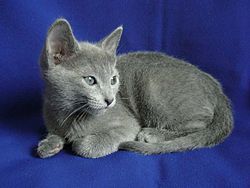Russian Blue: Difference between revisions
imported>Ro Thorpe m (→History: rm puff - looks like a tramp to me - only joking) |
imported>Ro Thorpe (→Appearance: rm incomprehensible clause - please modify & reinsert) |
||
| Line 19: | Line 19: | ||
== Appearance == | == Appearance == | ||
The Russian Blue has a short, dense coat that is called blue but really looks more like gray. The coat is silver tipped | The Russian Blue has a short, dense coat that is called blue but really looks more like gray. The coat is silver tipped. The Russian Blue should have green eyes. The cat has a wedge-shaped head. Their bodies look more like oriental cats such as the [[Siamese]]. They are lithe cats that walk softly | ||
== Temperament == | == Temperament == | ||
Devoted, quiet and loyal to their families, Russian Blue cats may shy away from strangers. They are [[intelligent]] cats and have been known to play fetch or open doors. They are excellent [[family]] cats. | Devoted, quiet and loyal to their families, Russian Blue cats may shy away from strangers. They are [[intelligent]] cats and have been known to play fetch or open doors. They are excellent [[family]] cats. | ||
Revision as of 14:03, 10 August 2010
The Russian Blue is a breed of cat. It is named for the silver-grey appearance of its plush 'blue' double coat.
History
As is the case for most of today's purebreds, the exact origins of this cat are somewhat murky. The accepted theory is that the cats most probably originated from Archangel (Arkhangelsk) or the White Sea in Russia. Russian sailors probably brought the Russian Blue to England and Northern Europe during the 1860s. Among the myths surrounding the Russian Blue cat is that it is a descendant of the royal cats owned by the Russian Czars.
The Russian Blue was first shown at the Crystal Palace, in England, in 1875. The Russian Blue, or the Archangel cat as it was known in 1875, was placed in the class for blue cats. By 1912 the Russian Blue was given a class all its own.[1]
Both English and Scandinavian breeders developed foundation bloodlines. The Russian Blue were imported to the United States starting in 1900. There is no recorded history of the Russian Blue being developed in the US until after World War II.
American breeders combined the bloodlines from both England and Scandinavia to create the modern Russian Blue.
Appearance
The Russian Blue has a short, dense coat that is called blue but really looks more like gray. The coat is silver tipped. The Russian Blue should have green eyes. The cat has a wedge-shaped head. Their bodies look more like oriental cats such as the Siamese. They are lithe cats that walk softly
Temperament
Devoted, quiet and loyal to their families, Russian Blue cats may shy away from strangers. They are intelligent cats and have been known to play fetch or open doors. They are excellent family cats.
References
- ↑ Error on call to Template:cite web: Parameters url and title must be specified. Retrieved on 2010-08-04.
